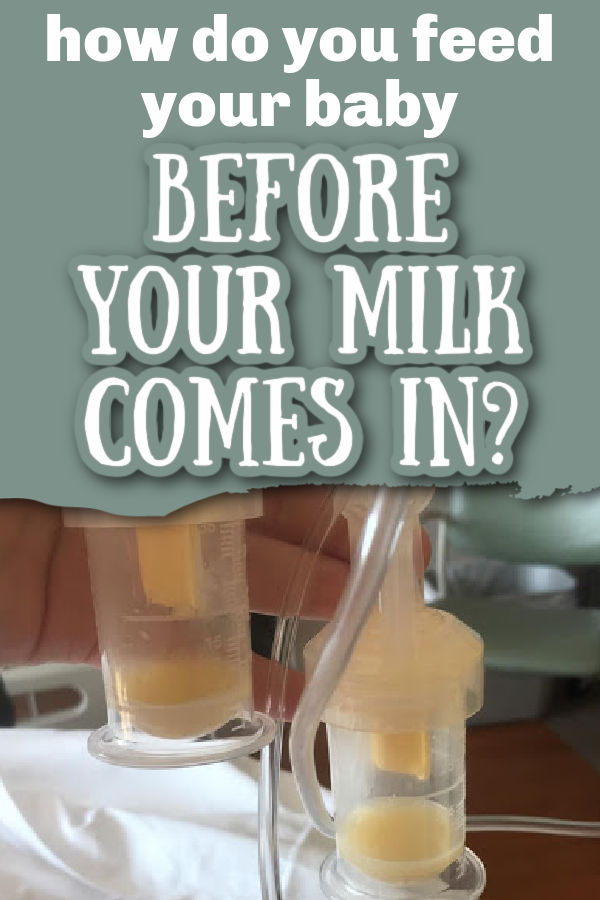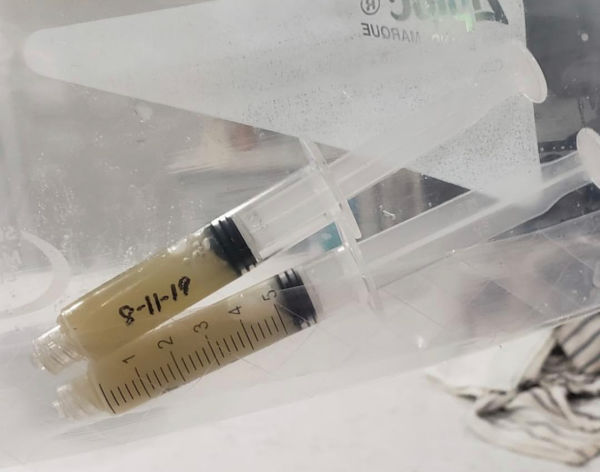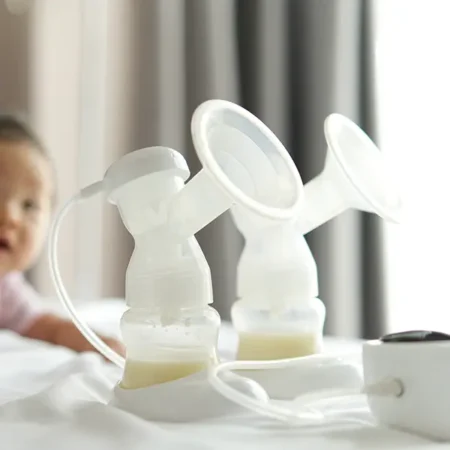Most new parents who decide to breastfeed find that their milk comes in a few days after birth. But how do you feed your baby before your milk comes in? Here’s what you need to know.

This post may contain affiliate links, which means that if you click a link and take action, I may make a small commission at no additional cost to you. I only recommend products I love! More info here.
When does milk production begin?
Milk production begins during pregnancy, usually in the second trimester. Some parents notice that they start to leak occasionally while they are pregnant, while other people do not.
(Whether or not you leak during pregnancy is not an indication of your future milk supply.)
The milk that is produced in pregnancy, and immediately after birth, is called colostrum.
What is colostrum?

Colostrum is a thick milk containing protection for newborn babies:
Colostrum, produced in low quantities in the first few days postpartum, is rich in immunologic components such as secretory IgA, lactoferrin, leukocytes, as well as developmental factors such as epidermal growth factor. Colostrum also contains relatively low concentrations of lactose, indicating its primary functions to be immunologic and trophic rather than nutritional.
More on the different types of breast milk here.
What does it mean for your milk to come in?
In the days after birth, the milk you produce usually changes in a few ways:
- It begins to change from colostrum to transitional milk to mature milk (mature milk consists of water, carbohydrates, fats, and proteins to keep baby hydrated and provide enough energy for growth).
- The volume produced usually increases quite a bit.
Much more on how your milk comes in here.
When does your milk come in after birth?
After you have your baby, it usually takes about 2-5 days for your milk to come in.
When it does, you may notice an increase in breast fullness (and potentially a feeling of engorgement), leaking, and a change in your baby’s behavior while nursing.
If you’re pumping/are able to see the milk, you might also notice it is lighter in color and not as thick.
So how do you feed your baby before your milk comes in? Do you need to supplement?
If you’re nursing your baby, you’ll want to nurse frequently. This is both to provide your baby with the benefits of colostrum, and to help you establish your supply.
Many parents are able to meet their baby’s needs with colostrum that they produce.
But how do you know that baby is really getting enough – especially when you can’t see what she’s getting?
Most hospitals and birthing centers will monitor baby’s weight and the number of wet diapers to make sure that she doesn’t lose too much weight or get dehydrated.
If anything becomes a concern, you pediatrician may discuss supplementing with formula with you until your milk comes in. Assuming all is going well, though, you shouldn’t need to use formula.
(But if you do, that’s totally normal and okay! You’re doing a great job.)
What if you need to pump colostrum?
If you’re planning to exclusively pump from birth and don’t want to nurse your baby before your milk comes in, you may need to try to pump colostrum.
Unfortunately, pumping colostrum (as opposed to nursing) can be a challenge. It’s a thicker milk, and I was able to pump a grand total of a few mL of it before my milk came in.
So what should you do if you have the same issue, and you aren’t able to pump much colostrum?
- Try hand expression. Lots of women find that they are able to get more this way.
- Try using a Haakaa (silicone breast pump). This is a small pump that suctions on to your breast and also seems to be more effective at pulling out colostrum than an electric pump.
If neither of these work, then you may want to discuss supplementing with formula with your baby’s pediatrician. Always give any expressed colostrum you have first, no matter how small the amount is.
If you do decide to supplement, keep pumping every few hours, as the nipple stimulation will help with establishing your milk supply (even if you’re getting little to no milk).
You can also try to harvest colostrum during pregnancy (after checking with your provider) to have it ready for baby after birth, if you’d like. More on this here.
Tell us your experience with feeding your baby before you milk came in, or feel free to ask questions in the comments!
References- American Pregnancy Association. “Breastfeeding Overview.” https://americanpregnancy.org/healthy-pregnancy/breastfeeding/breastfeeding-overview-copy-70904/
- Ballard O, Morrow AL. Human milk composition: nutrients and bioactive factors. Pediatr Clin North Am. 2013;60(1):49-74. doi:10.1016/j.pcl.2012.10.002 https://www.ncbi.nlm.nih.gov/pmc/articles/PMC3586783/
- Bonyata, Kelly. “When Will My Milk Come In?” Kellymom. https://kellymom.com/bf/concerns/mother/when-will-my-milk-come-in/












